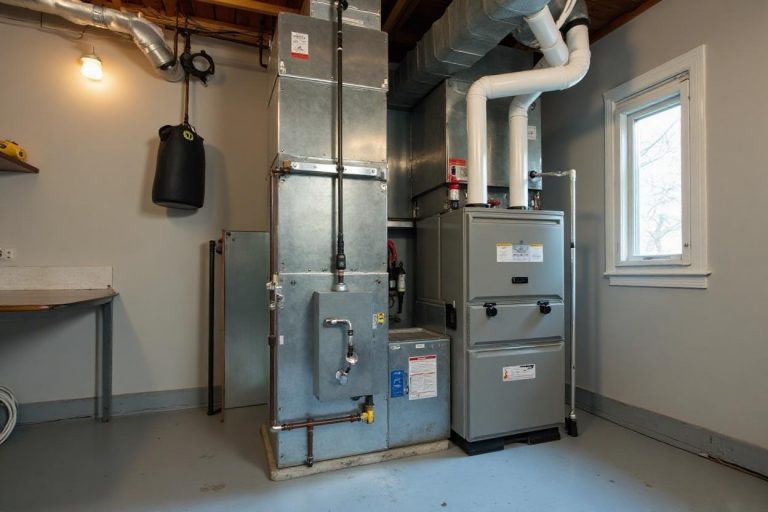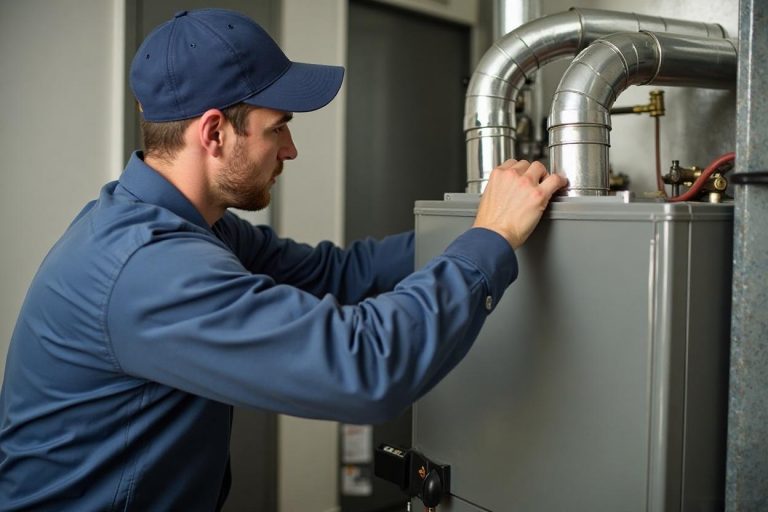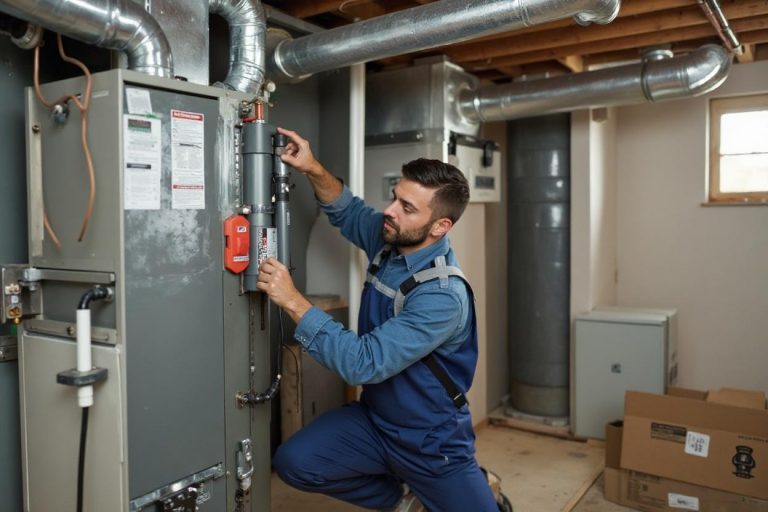How Often Should A Home Gas Furnace Be Serviced?
Homeowners in Middlefield, CT ask this question every fall: how often does a natural gas furnace need service? The short answer is once a year for a full professional tune-up, ideally before the first cold snap. A furnace can run without yearly attention, but it will cost more to heat the house, break down sooner, and carry higher safety risk. In a New England heating climate, a consistent maintenance schedule saves money, reduces stress, and keeps the home comfortable from Durham Road to Lake Beseck.
This article walks through timing, what the service includes, how to spot early warning signs, and how Middlefield conditions affect wear on a system. It leans on practical experience from hundreds of tune-ups across Middlesex County, where subfreezing nights and long run hours expose small problems fast. The goal is clear: help a homeowner decide when to schedule natural gas furnace maintenance, what to expect during the visit, and why a local HVAC team is the right partner.
The right service interval for Middlefield, CT
Annual service is the standard, and it is the right cadence for most homes in Middlefield. A furnace in this area typically runs from October through April, sometimes longer. That is a heavy-duty cycle compared to milder regions. Filters load with dust and dander from tightly sealed homes, combustion air can carry road salt residue and garage fumes, and condensate drains on high-efficiency models face freeze-thaw cycles. These conditions make a once-a-year tune-up the safe baseline.
There are cases where twice-a-year checkups make sense. Homes with pets, indoor workshop dust, or recent renovation debris push more particles through the return ductwork. Rental properties with variable occupant habits often see clogged filters and blocked returns. Older furnaces past 12 to 15 years benefit from a fall tune-up plus a mid-season check to catch igniter wear or flame sensor buildup before a no-heat call lands on the coldest night.
What “annual service” actually includes
A professional tune-up is more than a filter swap and a cursory look. A thorough service in Middlefield should include combustion testing, safety inspection, cleaning, and airflow verification. The technician should record readings and explain any drift from normal ranges. Homeowners should expect the visit to take about 60 to 90 minutes.
Here is what a proper natural gas furnace maintenance visit covers:
- Safety checks: verify gas shutoff operation, inspect flex connector, confirm proper flame rollout and limit control function, test carbon monoxide in the supply air and near the furnace, and check for exhaust leaks at the vent and inducer housing.
- Combustion and ignition: measure manifold gas pressure, inspect and clean the burner assembly, verify flame signal in microamps, clean or replace the flame sensor, and test the hot surface igniter resistance match for the model.
- Airflow and efficiency: measure temperature rise across the heat exchanger, check static pressure in the supply and return, inspect blower wheel and motor amps, and set fan speed for correct airflow based on the equipment’s rated temperature rise.
- High-efficiency items: on 90-plus AFUE furnaces, flush the condensate trap and drain, inspect the secondary heat exchanger surfaces for blockage, and verify the pressure switch operation with the inducer running.
- Housekeeping and controls: install the correct filter size and MERV rating for the duct system, check thermostat calibration, verify call-for-heat sequencing, and inspect wiring connections and ground.
These points prevent three common winter problems: nuisance lockouts from weak flame signals, short-cycling due to high static pressure, and cracked drain traps that back water into the furnace cabinet.
Why annual service pays off
The benefits are easy to quantify. Clean burners and correct manifold pressure recover efficiency lost to incomplete combustion. A clean filter and a balanced blower speed reduce runtime to reach setpoint. Verified temperature rise protects the heat exchanger from overheat stress, which extends its life.
A local data point helps. In service records across Middlesex County, furnaces with annual maintenance showed noticeably fewer emergency calls. No-heat calls dropped by roughly a third compared to units with irregular attention. That difference mattered most during cold snaps, when parts suppliers run thin and appointments stack up.
Energy use also reflects real change. A system with a clogged filter and a half-coated blower wheel can draw 10 to 20 percent more electric current at the motor and take longer to heat the home. After cleaning and proper fan-speed setting, the furnace cycles fewer minutes per hour. Over a full season in Middlefield, where furnaces can log 1,000 to 1,500 hours, that adds up.
Timing matters: book early fall if possible
The best time to schedule is late September through October. The temperatures are cool enough to test heating but warm enough to keep the house comfortable if the unit needs parts. Parts availability is better before the first widespread frost. The service calendar is also more flexible early in the season, which makes it easier to get preferred times.
If fall passed without a tune-up, January service still helps. A technician can spot an igniter near failure, a draft inducer bearing that is starting to howl, or a condensate trap that is gumming up. Mid-season corrections prevent a breakdown during a nor’easter when repair windows shrink.
What a homeowner can handle between visits
A homeowner does not need to wait for a pro to maintain a baseline of care. Simple monthly checks extend the benefit of the annual tune-up:
- Inspect and replace the filter on a schedule. In Middlefield’s heating season, check every 30 to 60 days. If the filter looks gray and fuzzy, replace it. Avoid high-MERV filters unless the duct system and blower can handle the added resistance.
- Keep the area around the furnace clear. Leave at least three feet of space to allow proper airflow and safe service access.
- Check the thermostat batteries annually if the unit uses them, and keep the thermostat away from heat sources and direct sun.
- On high-efficiency models, glance at the condensate line for kinks, sagging, or algae growth, and make sure the outlet remains open.
- Make sure intake and exhaust PVC pipes outside stay free of leaves, nests, and snow crust after storms.
These steps are quick and prevent many service calls. They do not replace the need for combustion testing, which requires instruments and training.
Signs that service is overdue
Some clues show up before a furnace stops heating. Short heat cycles with rising energy bills point to airflow or limit problems. A furnace that starts, stops, and immediately restarts suggests a flame detection issue. Metallic rattles or a scraping sound at the blower signal dirt buildup or bearing wear. An acrid smell at the start of a cycle can be dust on the heat exchanger or a motor overheating. A yellow, wavy flame rather than crisp blue indicates poor combustion or a cracked heat exchanger zone. Any carbon monoxide alarm requires immediate shutdown and professional inspection.
Homeowners often mention a dry, dusty feel in the house or uneven temperatures between floors. Those complaints often come back to duct issues, undersized returns, or fan speeds that were never set for the home’s actual ductwork. Maintenance visits catch those mismatches and allow a technician to suggest realistic fixes.

Middlefield specifics: cold snaps, basements, and older ductwork
Local housing stock matters. Many Middlefield homes have finished basements with mechanical rooms that share space with laundry and storage. Lint and cardboard dust reach return air and settle on blower blades. That load accelerates between annual services. Keeping storage off the floor and using lidded bins reduces airborne debris near the furnace.
Cold snaps stress pressure switches and condensate lines. On a zero-degree night, the pressure switch sees higher draft differentials and a sluggish inducer can stick the switch open. A technician who lubricates where appropriate and checks the inducer amps early helps avoid that failure. For condensate, uninsulated lines that run through unheated spaces may freeze. During a fall tune-up, a simple reroute, heat tape, or a short section of higher slope can prevent a midwinter lockout.
Duct systems in older homes often rely on a single central return. That setup raises static pressure when bedroom doors close, which pushes the furnace into a higher temperature rise than its rating. Maintenance visits can identify the pressure problem and suggest low-cost corrections such as transfer grilles, undercut doors, or a modest return upgrade. The change reduces burner stress and evens out room temperatures.

How service affects warranty and lifespan
Many furnace manufacturers state in their manuals that routine maintenance is required to keep warranties valid. They expect filters to be replaced, condensate systems to stay clear, and burners to remain clean. If a heat exchanger fails and a dirty filter or high static condition caused chronic overheating, a claim can be denied. Keeping annual service records protects the homeowner. It also signals to a future buyer that the mechanicals received care, which supports resale value.
On lifespan, most modern natural gas furnaces last 15 to 20 years in New England. Units with regular maintenance reach the high side of that range more often. Igniters, flame sensors, and inducer motors are wearable parts and do fail eventually. Replacing those parts during a planned visit is cheaper than an emergency call after-hours. Annual service also finds issues like a failing blower capacitor before it strands the home without heat.

The cost picture: service versus repairs
A typical annual tune-up costs less than a single emergency visit. In Middlefield, homeowners often see fall maintenance price points that are predictable and include the full checklist. Emergency calls on a weekend or night carry higher rates, and cold weather can stretch response times. Spending modestly each year avoids the $400 to $900 surprise of a no-heat repair compounded by after-hours fees.
Fuel savings are harder to pin down number for number because usage varies with weather. Still, a furnace that keeps its temperature rise in spec and breathes through a clean filter burns less gas per degree day. Even a small improvement of a few percent over a long heating season covers a large part of the tune-up cost.
Home air quality benefits
A clean furnace does more than heat reliably. It filters better and moves air more quietly. Dust burning off a heat exchanger at the first cycle of fall is normal. Persistent smells are not. Annual cleaning reduces those odors, and correct fan speed reduces drafts that stir dust. For homes near the Quinnipiac River valley where pollen can linger, a properly sized filter slot and a filter that matches the duct capacity support better indoor air. During a visit, a technician can recommend the right MERV level for the home’s return size and blower capacity. The wrong filter can choke airflow; the right one captures particles without harming performance.
High-efficiency furnaces need special care
Condensing furnaces above 90 AFUE squeeze extra heat from exhaust. They also produce acidic condensate that must be neutralized and drained. Traps and hoses collect debris and biofilm throughout the season. If the trap plugs, the furnace shuts down. During maintenance, the technician should remove, rinse, and reinstall the trap, inspect the neutralizer media if present, and confirm slope on all drain runs. The secondary heat exchanger surface needs a visual check and a pressure drop check if the manufacturer provides specs.
These units also rely on pressure switches that need clean tubing and intact diaphragms. A simple crack in a hose or a pinched section near the cabinet can cause intermittent faults. An annual look at these lines prevents a frustrating, once-a-week lockout.
What to expect during a Direct Home Services visit
A local team that works on furnaces across Middlefield understands these patterns and carries the parts that fail most often locally. During a maintenance appointment, the technician arrives on time, protects floors, and asks about any recent noise, smell, or performance changes. The work begins with safety, then cleaning, then measurements. Readings are shared and discussed in plain terms. If a part is weak but not failed, the technician explains https://directhomecanhelp.com/gas-furnaces the risk and the timing. The homeowner chooses whether to replace now or monitor. The goal is a comfortable home all winter without surprises.
Direct Home Services supports Middlefield neighborhoods from the town center to the Route 66 corridor. Same-day service is available in the fall for tune-ups, with emergency support during snow events. The team documents work done and sets reminders for the next season if requested.
Natural gas furnace maintenance and energy rebates
While tune-ups themselves are typically out-of-pocket, they position a homeowner to qualify for incentives if a replacement becomes wise. A maintenance visit can reveal duct constraints or home leakage that suggests a future upgrade path. If a furnace is in the 20-year range with repeated repairs, a technician can provide equipment sizing and venting notes that speed a future quote. When that time arrives, having a maintenance history helps verify the system’s baseline and the gains a new unit will deliver.
The edge cases: vacation homes, frequent filter changes, and smart thermostats
Not every home runs a furnace the same way. A Middlefield home used on weekends may cycle a furnace in bursts. It still needs annual service because burners corrode faster when equipment sits idle. On the other end, a home with a wood stove that supplements heat might stress the furnace during morning recovery periods when the thermostat calls for a quick ramp. These spikes make clean burners and a healthy igniter even more important.
Some homeowners swap filters monthly without fail, which is good, but too restrictive a filter can raise static pressure and harm the blower. During maintenance, the technician can test static and recommend the right filter grade.
Smart thermostats can save energy, but incorrect configuration can cause short cycling or lockouts. Professional maintenance includes checking thermostat settings such as heat cycle rate and compressor lockout for dual-fuel systems. That step smooths operation and cuts wear.
How to schedule service in Middlefield, CT
The easiest plan is to book in late summer or early fall and set a recurring reminder. Many homeowners tie it to seasonal tasks such as gutter cleaning and smoke detector battery checks. Direct Home Services offers convenient scheduling online and by phone, with clear arrival windows and text updates. For homes that missed fall service, slots remain through winter, and a mid-season tune-up still prevents problems.
If a furnace is noisy, cycles strangely, or throws an error code, do not wait for a full failure. Write down the code and any pattern you notice. A technician can use that detail to zero in on the fault faster.
A practical, local answer
So how often should a home gas furnace be serviced? In Middlefield, CT, once a year is the right rhythm for safety, efficiency, and longevity. Homes with high dust loads, older equipment, or frequent no-heat history benefit from a second mid-season check. Service should cover combustion testing, airflow verification, cleaning, and drain maintenance for high-efficiency units. Homeowners can handle filter checks and clearances; a trained technician handles the instruments and safety controls.
Direct Home Services stands ready to help local homeowners stick to that schedule. The team knows the quirks of basements off Lake Road, the way salt and slush affect garage-located units near Jackson Hill Road, and how to keep high-efficiency drains clear when the temperature dips into single digits. Schedule an annual natural gas furnace maintenance visit now, and the home will be ready for every cold front that rolls over the ridgeline.
Direct Home Services provides HVAC repair, replacement, and installation in Middlefield, CT. Our team serves homeowners across Hartford, Tolland, New Haven, and Middlesex counties with energy-efficient heating and cooling systems. We focus on reliable furnace service, air conditioning upgrades, and full HVAC replacements that improve comfort and lower energy use. As local specialists, we deliver dependable results and clear communication on every project. If you are searching for HVAC services near me in Middlefield or surrounding Connecticut towns, Direct Home Services is ready to help. Direct Home Services
478 Main St Phone: (860) 339-6001 Website: https://directhomecanhelp.com/ Social Media:
Facebook |
Instagram
Map: Google Maps
Middlefield,
CT
06455,
USA